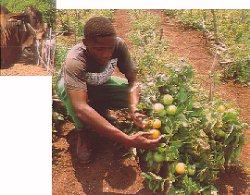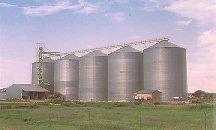


THE thrust of government policy in the agricultural sector continues
to focus on development of a diversified rural economy less dependent
upon subsistence agriculture and based increasingly on other activities.
The main objective, then, is to encourage and facilitate the
creation of sustainable incomes and alternative employment-generating
opportunities based on sound environmental management.
A field worker inspects tomatoes in the field. Inset: Brahman bull at a stud farm near Francistown.
Although agriculture no longer claims a significant portion of the Gross Domestic Product, it is still relied upon by the great majority of Botswana living in rural areas and dependent on agricultural activities for their livelihoods. The principal agricultural industry is livestock, earning welcome foreign exchange in the form of beef exports and raw materials from meat processing. The primary arable crop is sorghum, which is drought resilient.
Through implementation of drought relief measures during the 1993/94 financial year the government minimized the adverse effects of these drought conditions on rural communicates. Inter-sectoral collaboration in the implementation of rural development policies and programs is ongoing.
As a result of the improved rainfall situation (which has been
above the normal average in many parts of the districts), about
290000 hectares of land have been planted in comparison with the
263,000 hectares for the whole of the 1992/93 planting season.
The extent of ploughing and planting is expected to exceed that
of many previous seasons, with government assistance (in form
of free seeds and financial grants for ploughing and row planting)
having been timely. With regard to the livestock sector, there
has been little change in the offtake rates estimeted in the 1990
agricultural surveys. In the interest of economic management
as well as protection of the environment from degradation caused
by the rapid increase in livestock numbers, the Ministry of Agriculture
is exploring ways of raising offtake rates, especially among traditional
farmers.

Sorghum field.
MAIZE, SOURGHUM
Competion from South Africa and Zimbabwean millers of maize is likely to increase as those countries seek to overcome difficulties in their home markets by exporting to Botswana.
Although the 1992/93 financial year was an extremely difficult
one, the Botswana-owned company known as Sefalana (meaning 'the
bountiful granary') maintained its position as the leading wholesaler
and manufacturer of basic foods, with mills working at full capacity.
At Lobatse, Pilane and Serowe, the company operates maize mills,
a sorghum mill and balanced animal feed plants.

Chemically- free ranch lands provide grazing for the national herd of cattle. ->
BEEF PRODUCTION
Established by the government in 1996, the Botswana Meat Commission (BMC) co-ordinates the production of beef from a national herd of some two to three million grazing on chemically-free ranch lands covering much of the country's 580000 square kilometers. As the sole exporter of lean beef which features prominently in markets throughout the world, particularly the EC, the BMC has changed from a flat structure to seasonal prices in order to bring the BMC in line with both the EC and South Africa prices, where most of its beef was sold. Response from the farmers has been encoring, with increased kills having been reported at all of the three abattoirs.
Facilities at the BMC headquarters in Lobatse have been designed and constructed as a complete and integrated complex of abattoir, canning, tanning and by-products plant to handle a throughput of 8000 cattle and 500 small stock per day. Branch abattoirs are operated in the north-west of the country at Maun, with a capacity of 100 cattle per day, and in the north-east at Francistown with a capacity of 400 cattle and 150 small stock per day.
The BMC owns a marketing subsidiaries in the United Kingdom, Germany and Holland, an insurance company in the Cayman Islands, cold storage facilities in the United Kingdom and South Africa, and transport companies in Botswana.
The Botswana Livestock Development Corporation was formed for the purpose of buying cattle not yet ready for slaughter - these are fattened after purchase and then sold to the BMC. The corporation is designed to help cattle owners in more remote areas where prices for cattle are lower than in those areas closer to the main abattoirs. Although most of Botswana's cattle are reared for beef production, there is also a dairy industry, still relatively in its infancy. Import controls have been instituted to encourage the production of milk and milk products.
The Department of Veterinary Services also helps in livestock
production by providing livestock advisory services, operating
a diagnostic laboratory for disease control and carrying out meat
inspections.

Metal silos of the Botswana Agricultural Marketing Board at Pitsane.
AGRICULTURAL PROJECTS
The agricultural division of the Botswana Development Corporation oversees those companies engaged in commercial farming , poultry, beef, diaries, as well as greenhouse, mushroom and large-scale irrigation, with special emphasis on the efficient use of scarce water resources. In addition, assistance is provided in the evaluation of feasibility studies of new agricultural projects - management advice extends from assisting both small and large-scale commercial operations and non-governmental organizations on different irrigation systems.
FORESTRY AND ENVIRONMENT PROTECTION
Concerted efforts are made to conserve and regenerate Botswana's valuable but ever-diminishing forests. Overgrazing and damage to seedling by livestock have denuded part of the country of trees - notably in the south and around the larger villages. Tree plantation programs are helping to alleviate this problem, at the same time increasing public awareness of trees as protectors of the environment and providers of useful products.
In the north-east of Botswana a large area of deciduous forest produces timber of commercial quality, mainly mukwa and mukusi. Areas containing the particularly valuable mopani trees spread to the north and west. Both of these produce nuts with edible kernels - the soft wood of the morula is used for making bowls, plates and tourist items, and its fruit for making beer. The baobab, which can live to a great age with a circumference of more than 30 metres, is also dominant in the north.
There are numerous forest reserves in the Chobe district, the northern Nata state lands and the land north of the Okavango Delta, with inventories either already undertaken or being planned. Such inventories are effective in establishing the quantity of timber available for commercial exploitation, as well as new areas to be investigated for timber concessions. It is also hoped to balance the exploitation of existing species in order to even out natural regeneration.

 go back
go back